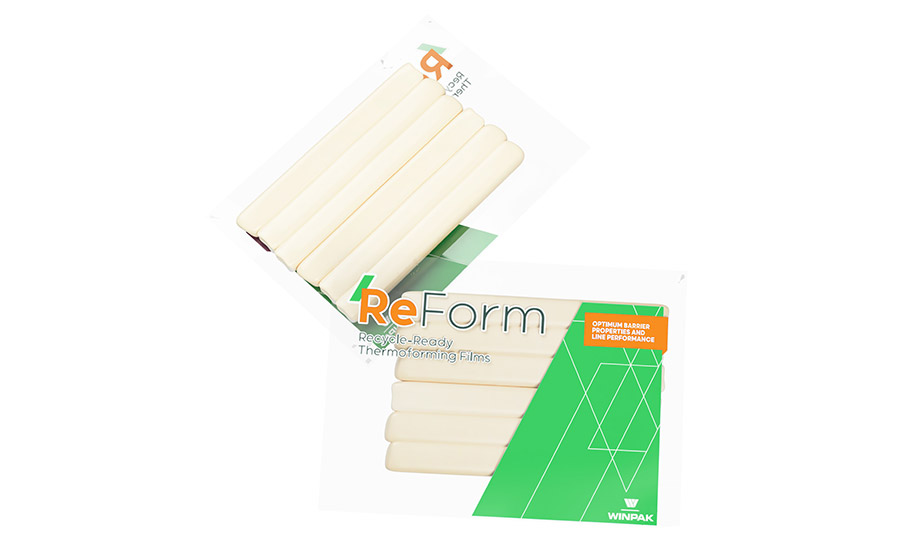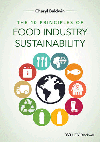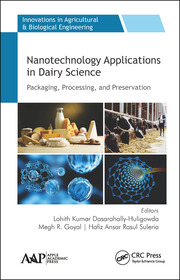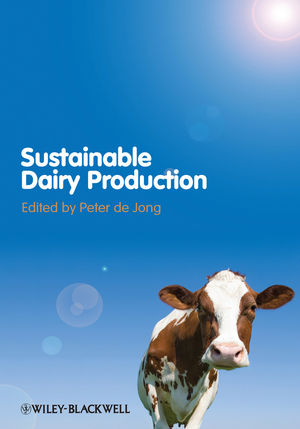Packaging serves as a major piece of the sustainability puzzle
After a brief hiatus, consumer demand for sustainable packaging is increasing.

The dairy industry has taken substantial steps forward in sustainable packaging, according to Multivac’s Ryan Spencer.
Photo courtesy of Multivac.
Easily one of the biggest components on the path to sustainability is packaging. Without advancements in packaging, it would be extremely difficult for dairy processors to meet their future sustainability goals.
Fortunately, the dairy industry is on a good path. Recyclable packaging, using less plastic, lightweighting, switching materials, and using post-consumer recycled content are the top ways in which dairy companies are making sustainable changes to packaging, Rebecca Marquez, director, custom research for PMMI, the Association for Packaging and Processing, tells Dairy Foods. “Consumers are demanding that the products they consume are packaged in materials which are sustainable. It is to the dairy processors’ advantage to listen to their consumers, not to mention the regulatory demands from industry and legislative bodies,” she says.
“I think the dairy industry has taken substantial steps forward in sustainable packaging. It’s very encouraging to see,” adds Ryan Spencer, product marketing manager for Kansas City, Mo.-based Multivac Inc. “Of course, we are still early in the journey and more can and will be done. It can absolutely be an advantage. Differentiation is so difficult in the food industry and convincing people that your product is produced and packaged with environmental concerns in mind can absolutely move the needle with unit sales.”
The flexible packaging industry is working to achieve a circular, sustainable economy by developing products that reduce waste and increase recycling rates, adds Christopher Gabriel, strategic marketing director at Chicago-based TC Transcontinental Packaging. “These innovations largely focus on developing recyclable mono-material structures, advanced compostable films and increasing the use of post-consumer recycled content,” he says. “Transitioning to more sustainable packaging products will certainly help dairy processors deliver on their sustainability targets.”
A big part of the sustainable equation is aseptic processing and packaging for shelf-stable dairy milk. “Tetra Pak aseptic cartons allow for lower carbon impact by eliminating the need for refrigeration during transport and storage. Shelf-stable milk has a shelf life of six months or more when unopened, leading to reduced food waste resulting from spoilage and unplanned incidents like electrical outages,” notes Jordan Fengel, sustainability manager, Tetra Pak U.S. and Canada, based in Denton, Texas. “…Aseptic packages are shipped in a roll from our converting plants to our customers’ filling locations, allowing more unfilled products to fit on each truck and reducing the number of trucks on the road. Less shipments also mean transportation savings.”
Sustainability and consumers
Sustainability is not only important to dairy processors. The consumers they serve also place great emphasis on the topic.
“Sustainability continues to be an increasingly important issue for the packaging value chain. At the same time, consumer awareness is also growing. As societies emerge from the COVID-19 pandemic, consumer sentiment is evolving away from a hyperfocus on hygiene,” McKinsey & Co. states in its “Sustainability in packaging 2023: Inside the minds of global consumers” report.
However, the “majority of consumers are less concerned about hygiene and food safety than they were during the pandemic, even though their level of concern is still above where it was before the COVID-19 pandemic,” the report adds.
Packaging suppliers acknowledge there was a brief decline in consumer demand for sustainable packaging. Consumer interest is on the rise again though. “Pre-COVID, we received an increase in our customers inquiring about sustainable options. This interest is starting to come back this year as businesses are finally starting to get back to a normal pace,” says Murray Bain, vice president of marketing for Stanpac, Smithville, Ont.
On-pack recycled content information and carbon reduction claims are also on the rise. “Globally, we are seeing rising challenges toward how we use our planet’s resources while ensuring food systems can support a growing population,” Fengel relays. “Packaging is critical to keeping food safe and in extending shelf life to reduce food waste. For this reason, consumers are increasingly looking to brands to address food waste.”
More sustainable packaging solutions are included in the total value bundle, along with nutritional benefits, cost value, and product quality, adds Darin Gregg, dairy market director for Winnipeg, Manitoba-based Winpak. “In terms of recyclability, consumers are looking for guidance and information, like the How2Recycle label, to instruct them on proper disposal,” Gregg suggests. “In addition, QR (quick response) codes or digital watermarking on packaging allow for communication to consumers of key information. This could include information and pictographs related to recycling of the packaging, as well as related information on recycling to educate the consumer on its importance.”
The sustainability mega-trend is here to stay, stresses Gabriel. “Brands and producers are working to understand what this means for their business and are exploring a wide range of packaging options such as compostable films, utilizing post-consumer resin (PCR) and recycle ready films, to meet both consumer expectations and their own sustainability goals.

“For processors, success means having a solution that keeps food safe and protected, extends shelf life, reduces waste, and achieves the desired visual presentation for consumers while still achieving operational targets on existing capital equipment,” Gabriel continues.
Consumer demand for sustainable packaging is real, and the data backs this up, Spencer adds. “Even in the recent economic environment of high inflation and pain from food price hikes, more than 80% of consumers in general indicated they are willing to pay more for sustainable packaging,” he says. “But customers don’t want to give up usability for sustainability. The new packaging must provide the same ease of use, attractiveness and preservation of product as the old stuff.”
Spencer calls this a “challenge for those of us who specialize in packaging, but I think it’s one we are ready and able to take on.”
2030: A sustainability odyssey
Many dairy processors have targeted 2030 as the date they expect to achieve significant reductions in carbon emissions. This is not a random date. Instead, the Intergovernmental Panel in 2018 pointed to 2030 as a specific breaking point to ensure the earth does not face an elevated risk of devastating floods, drought and extreme poverty for millions of people.
Of course, sustainable packaging is only one aspect of the larger equation to meet these goals. “However, the nice thing about a sustainable packaging initiative is it is somewhat straightforward compared to other pieces of the carbon emission reduction puzzle, such as on the product raw material side or logistics,” Spencer reveals. “A win can be achieved even with just a small change such as using a thinner plastic, or even replacing plastic interleaver sheets between cheese slices with a spray system such as we have on our MULTIVAC S1600 slicer.”
Gabriel stresses that moving toward more sustainable packaging is a critical component of reducing carbon emissions and achieving sustainability goals. “Recycled plastic materials require less energy for production and keeping plastics out of the waste stream greatly improves greenhouse gas emissions by reducing both demand of virgin resins and end of life environmental costs,” he notes.
The No. 1 way for dairy packaging to be more sustainable is for consumers to recycle it, relays A.J. Miller, director of marketing, Silgan Closures, Downers Grove, Ill. “The dairy industry uses a lot of HDPE (high-density polyethylene) plastic jugs with HDPE closures. This packaging is 100% recyclable. It simply needs to be placed in the recycling cart.
“Aluminum and steel, which are also great packaging materials, are viewed as sustainable because they have high recycling rates,” Miller continues. “Part of the reason for their high recycling rates is because a market exists for recycled metal. Companies will pay for those materials. Recently, high demand has developed for recycled milk jugs.

“HDPE milk jugs are one of the best materials to make PCR (post-consumer recycled) or post-consumer resin,” Miller adds. “PCR can be incorporated into new milk jugs to make them more sustainable. But the industry needs more PCR available. Which means we need consumers to recycle their milk jugs and closures.”
One thing dairies can do immediately to improve packaging sustainability is to include how-to- recycle information on their containers. “When recycling milk jugs or dairy cartons, it is important to place the closure back on the container before placing it in the recycling cart,” Miller says. “A closure or cap is too small to make it through the recycling process by itself. When the closure is attached to the container, the container will carry the closure though the recycling process to the correct recycling stream.”
Is plastic bad?
Plastic has long been important for dairy packaging. But is plastic part of the problem or part of the solution?
Plastic is a “miracle,” which has helped preserve billions of pounds of food from spoiling, Spencer asserts. “But because plastic has grown to be so inexpensive and so readily available everywhere, it is used in nearly every packaging application, even when it is unnecessary. In MULTIVAC’s view, there likely will always be a need and a place for plastic packaging.
“The key will be to identify those applications where other materials can do the job as good or better than plastic and make the switch,” he adds.
Miller concurs that “plastic is good.” “Plastic is one of the most sustainable packaging materials. When compared to metal and glass, plastic packaging has a much lower carbon footprint because it creates the least emissions when it is made,” he said, citing McKinsey & Co.’s “True packaging sustainability: Understanding the performance trade-offs” report.
In addition, plastic weighs less than other materials, reducing freight emissions when transporting dairy in plastic packaging versus heavier packaging materials, Miller continues.
“Sustainable packaging can help dairy processors reduce their emissions. If dairy processors use packaging that incorporates PCR or advanced recycled materials, their products will have lower carbon footprint,” he adds. “In addition, dairy processors can lower their carbon footprint by purchasing their packaging from vendors who manufacture with renewable energy.”
Another way to reduce packaging’s carbon footprint is to reduce the amount of resin used in the packaging. “Manufacturers have been lightweighting packaging for years. When lightweighting, it is a delicate balance between removing resin from a closure and maintaining superior application and performance,” Miller says.
Plastic used in dairy packaging is quite sustainable, adds Gregg. “It functions in its role to protect the package contents in an effective manner and normally with the least amount of packaging. Further, plastics (versus other package materials) are low in greenhouse gas (GHG) emissions and in overall resource use,” he says.

When considering improvements to plastic sustainability, several thoughts come to mind, Gregg notes. “First, the use of recycled content plastic is a viable option today. The use of recycled content supports a circular economy and reduces dependency on virgin, fossil fuel plastics. Second, plastics, mainly PE (polyethylene) and PP (polypropylene), made from bio-renewable resources are an option that both reduce the need for fossil fuel plastics and lower GHG emissions. In addition, ensuring that a package is optimized, which may mean down-gauging or lightweighting, should also be considered. Reducing a package’s overall weight is the single best step to improving sustainability.”
Plastics can and should be part of the solution, Marquez states. “However, we currently lack the recycling infrastructure to properly manage recovery and end-of-life for many of the plastic materials we use for packaging today. There are plastic alternatives available, but in some cases, they are perceived as expensive for brands to adopt, cannot maintain products freshness for the expected shelf life, may not work well with the installed base of packaging machinery, or are difficult to scale.”
Still work to be done
Clearly, dairy processors have successfully incorporated packaging as a way to reach their sustainability goals. PMMI reports “suggest that innovation and investment in recycling technologies, such as artificial intelligence and advanced sorting systems, could enhance the recyclability of flexible plastics and align with the growing consumer demand for sustainable packaging options,” notes Marquez.
Packaging sustainability progress has been excellent, but there is much still to accomplish however. “Industry and policymakers must prioritize these efforts to increase the rate of progress that is being made,” suggests Multivac’s Spencer. “But advances in material science, a shift in how producers view the responsibility in the full lifecycle of their products and growing consumer preference of sustainable packaging options will help us achieve more environmental wins in the future.”
Stanpac’s Bain also points to the need for more legislative regulation. “The biggest and hardest piece of the puzzle is the patchwork and fragmented recycling and composting regulations and systems throughout North America,” he relays. “Rules can be different from county to county or state to state making it difficult for any regional or national brand to have their product recycled across their market. It is unfortunate that a more robust system is not in place to recover and reuse materials that could be of value for new packaging products or other uses.”
Mandatory front-of-pack labelling will undoubtedly continue to grow, requiring more and more brands to be transparent in their ingredients and sourcing practices, predicts Tetra Pak’s Fengel. “Thoughtful consideration toward the overall design of products across the value chain is a trend that’s moving to become the standard. In this sense, design can include careful consideration of the materials being sourced, designing with recyclability in mind, and the consideration of opportunities to use the product in the future as post-consumer materials,” he says.
Expect to see products that support social initiatives, local communities and projects, inclusivity and accessibility, specific groups, and the environment, Fengel adds. “To continue to innovate toward sustainability, Tetra Pak is on a journey to develop the world’s most sustainable food package, which is fully made of responsibly sourced renewable or recycled materials and is fully recyclable, and carbon neutral. In 2021, Tetra Pak committed to invest €100 million a year for the next five to 10 years towards these efforts. We’re simultaneously developing innovative food processing and packaging technologies and equipment to reduce water, energy and waste.”
Dairy packaging has a strong and sustainable future, predicts Winpak’s Gregg. “Single-serve and multi-serve yogurt containers made of PP are recyclable and can contain recycled content. HDPE milk jugs are one of the most recycled packages of any material today. Beyond these formats, flexible packaging innovations are available today that are recycle ready and are lower in GHG emissions. These flexible packaging innovations are typically >20% lower in GHG emissions versus traditional packaging structures. They can also incorporate recycled content to better support the circular economy,” Gregg says.
“Additionally, digital watermarking is a solution being advanced today to support improved recyclability and traceability, especially in the area of flexible packaging,” Gregg concludes. This technology is expected to grow and support the growth of recycle ready flexible dairy packaging.”
As a special sidebar, Ricky Low, marketing director, R.A. Jones, A Coesia Co., Covington, Ky., added some comments as well.
1. How has dairy packaging become more sustainable? Can it provide an advantage to dairy processors?
Dairy packaging has evolved significantly towards sustainability, with innovations like the Pouch King enabling the use of environmentally friendly materials without sacrificing operational efficiency. This machine can operate at speeds up to 2,000 pouches per minute, demonstrating that high-efficiency production and sustainability can coexist. For dairy processors, this means meeting both consumer expectations for sustainability and regulatory requirements while also benefiting from operational efficiencies.
2. Are you seeing significant consumer demand for sustainable packaging? What specifically are they seeking in their products?
There is a growing consumer demand for sustainable packaging, driven by heightened environmental awareness and regulatory pressures, especially in the European Union. Consumers are increasingly seeking products that use recyclable and biodegradable materials, pushing companies to innovate in how packaging materials are sourced and processed.
3. Most dairy processors aim to reduce carbon emissions by 2030. Can sustainable packaging be a piece to this puzzle and how?
Sustainable packaging is a critical component in the dairy industry's goal to reduce carbon emissions. By enabling the use of recyclable and biodegradable materials, technologies can help minimize the carbon footprint associated with packaging production. This aligns with broader industry goals of achieving sustainability, as efficient packaging solutions reduce waste and energy consumption throughout the supply chain.
4. Plastic can be difficult to replace, especially in milk containers. Can plastic be part of the sustainable solution? Also, please describe some plastic alternatives that are sustainable.
While plastic remains a challenge to replace, particularly for liquid dairy products, it can still be part of a sustainable solution when used responsibly. R.A Jones’ Wraptor multi-style wrap-around carton creates glue-free, 100% recyclable paperboard wrap-around cartons, providing an eco-friendly alternative to traditional plastic hi-cones, which are being banned in Canada. The Wraptor can be used for packing dairy bottles and yogurts, enhancing sustainability in dairy packaging by reducing plastic use and promoting recyclability.
5. How can packaging become more sustainable in the future? What still needs to be done?
The future of sustainable packaging lies in continuous innovation in both materials and machinery. There is a need for further development in biodegradable and compostable materials that do not compromise the quality or safety of food products. Equipment is pivotal, as it allows for real-world testing and adaptation of these new materials at production scale, ensuring that sustainability goals can be met without compromising efficiency or product integrity.
Looking for a reprint of this article?
From high-res PDFs to custom plaques, order your copy today!









